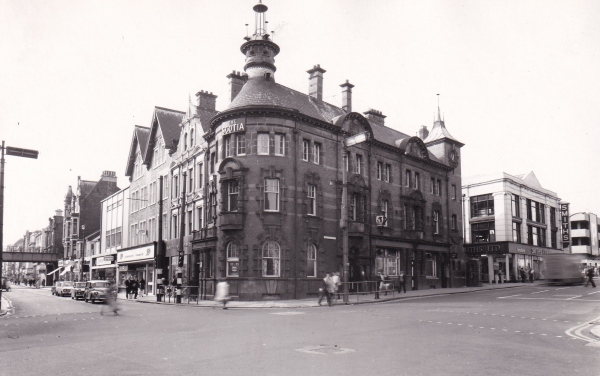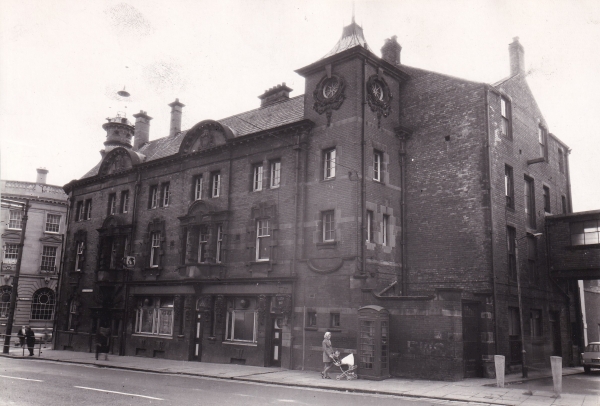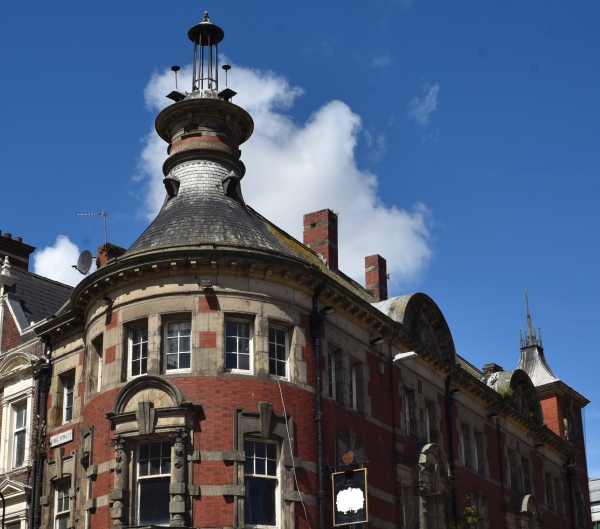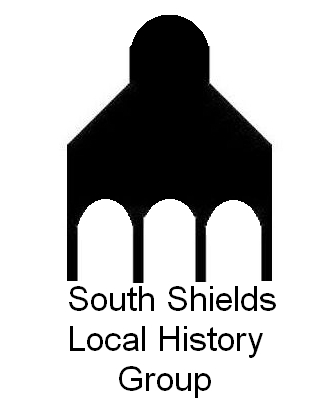| No | Pub Name | Postcode | Notes |
| 1 | Mechanics Arms, 3 East Street | NE33 1BW | Open |
| 2 | Lambton Arms, 5 East Street | NE33 1BP | Closed |
| 3 | The Railway, Waterfront, Log Fire Pizza Co | NE33 1EQ | Open |
| 4 | The Steamboat, 27 Mill Dam | NE33 1EQ | Open |
| 5 | Alum House, Ferry Street | NE33 1JR | Open |
| 6 | Old Highlander, 90-94 King Street | NE33 1JE | Closed |
| 7 | Coach and Horses, 67-69 King Street | NE33 1HU | Closed |
| 8 | Bridge Hotel, 36-38 King Street | NE33 1HU | Closed |
| 9 | Scotia, King Street/Mile End Road | NE33 1TS | Open |
| 10 | Ship & Royal, 1-3 Ocean Road | NE33 2HT | Open |
| 11 | Criterion, 2a Ocean Road | NE33 2HZ | Open |
| 12 | Stag’s Head, 45 Fowler Street | NE33 1NS | Open |
The route from South Shields Interchange if travelling by Metro or bus. If unsure of the pub location put the postcode into Google maps.

1 Mechanics Arms
Opened about 1869 by John Elliott as The Mechanics’ Hotel. The Ordnance Survey map of 1860 shows it as 3 separate buildings which were then knocked into one pub. It is one of six bars in Shields that have been called Mechanics’.
In the early 1900s it was owned by Westoe Breweries and was taken over by Bass Charrington in 1968.

Between 11 July 1974 and 7 October 1982 James Richard Briggs Dixon was the Licensee. Richard was a legendary character. He fixed a 50 pence coin on the floor and if you bent down to pick it up you were obliged to put 10 pence in the charity box!
In the early 2000s it changed its name to become Hanlon’s Well.

It has changed back to being called The Mechanics Arms now. The building was owned for many years by Cameron’s but is now run by a subsidiary of Greene King.
Inside the Mechanics on the left would have been a snug and is now a lounge area there is a large central bar and at the right is the main bar area where karaoke is sometimes played.


Built in the 1790s and called the Lord Collingwood. In 1835 it became the Lambton Arms. The front of the bar was in King Street on the 1860 OS map. It was rebuilt in 1892.
2 Lambton Arms

Beer engines (pumps) weren’t installed in the Lambton until 1960. Prior to that, beer was pulled straight from the wood and had to be carried up from the cellar!
It changed its name to The Smugglers in the early 1980s.

Alongside the Lambton is a very narrow alley way which links King Street to East Street and is called the “Lambton Snicket”.

The interior of The Lambton consists of one room with the bar at the back. There is a small single bar with a quite a selection of whiskeys at the right of the bar.

In cold weather there is always a log fire burning and any new customers are instantly drawn to this like a magnet.

The Lambton is unusual in that it used to open at 7.00 in the morning.
3 Railway
The Railway was originally called the Brighton Beach and it was first mentioned as a pub in 1821 when George Marchbank was the licensee.
It became The Railway in 1844 named after the Low Station which was just behind the pub. It was rebuilt about 1890.

It was a Tetley’s pub this was never a popular brewery in South Shields compared to Scottish and Newcastle.

Harry and Isobel Mallett were very popular mine hosts of the Railway between 1987 and 1996.

It closed about 1997 and then became The Waterfront in 2001.
The Railway is called The Log Fire Pizza Co now.
4 Locomotive/Steamboat
The first Licensing record for the Locomotive Inn dates back to 1850 with Emmanuel Hayton the licensee. Maria Pike held the licence in 1856.

On the 4th December 1947 it changed its name from “Locomotive Inn” to “The Locomotive”

It changed its name from The Locomotive to The Steamboat in the late 1970s.


Joe Mooney was the Landlord from about 1990 for over 30 years.

The pub extended into the old Post Office which had belonged to John Gaddes.


One of the many characters in the pub was Erasmus Bottle also known as Dave Walker a former BBC man who used to give humorous and interesting talks in the Steamboat.




Between 2008 and 2018 it won the Local CAMRA Pub of The Year 8 times! In 2020 Kath Brain became Licensee.
It is a Grade II listed building. The Steamboat is still a great pub now.

5 Alum House
he Alum House is the oldest licensed building in South Shields. The building dates back to the 1700s but it is not mentioned as pub until 1838. The Ship and Harbour Lights both predate this as pubs.

The Alum House takes its name from the Alum Shale which was off loaded nearby for use in Isaac Cookson’s Chemical Works. Alum was used in glass making and making Epsom salts.

The Alum House was owned by the Wood brewing family for over 100 years. In 1937 the Alum became the drawing offices for Tyne Dock Engineering.


During the war it was used as a base for the Home Guard in the 1980s it was used to sell furniture.

In 1989 it became a pub again owned by the Vaux brewery.





It is owned by Marston’s Brewery now.
6 Old Highlander
Richard Walton was licensee of the Highlander in 1827 in 1834 he called it the “Old Highlander”.

It was rebuilt in 1878 and was a contender for the longest bar in South Shields.

From the 1930s it was a Truman’s pub, it underwent alterations in 1936.


It closed in the mid 1960s it then became a shop.

From about 2010 it was Vision Express, it is unused now.

7 Coach and Horses
In 1839 it was called the Brick and Tile because of its close proximity to the nearby brickworks. In 1846 it became The Coach & Horses, this was on the corner of King Street and Waterloo Vale. It was a mail posting station and hence where the pub’s name derives from.
In the Wards 1873-74 Trade Directory W. Davis is licensee at 65 King Street. By 1875 Peter Gaffiney is operating as a “Bacon Factor” from 65 King Street and the pub ceases to exist.

In about 1900 it became the old Midland Bank, it bears a passing resemblance to the Addams Family House!

In the 1930s it became a shop called Weaver to Wearer, then in the 1970s it became the men’s fashion shop called John Temple it then became Greenwood’s Menswear.

It is now a furniture shop called Welcome Home.
8 Bridge Hotel
The Bridge Hotel dates from the 1820s the licensee was Thomas Robson and it was originally called the King’s Head. With the opening of the Stanhope and Tyne Railway Bridge in 1834 the name was changed to the Bridge Inn.

Seemingly before the station at Mile End Road was built you had to get your ticket in the back room of this pub!
The rear tiling still has the name Bridge Hotel visible on the Queen Street entrance. The entrance to the bar was mainly from Queen Street and was quite small. The building later became Caxton’s Shoes.


It was rebuilt probably in the 1890s.The brick work is really ornate and the gargoyles are a treat.

Gargoyles were used in medieval buildings to keep evil spirits away and dragons.


From 1919 it was owned by Newcastle Breweries. The Buffet was in King Street and passage lead from the front door through to the bar and another door leading into the buffet. It closed in 1973.

It was BETFRED Book Makers until 2023.

9 Scotia
The Scotia stands on the corner of King Street and Mile End Road.
The first mention of a pub at this location is the Fountain Tavern in 1867.

There is then mention of a Nova Scotia Hotel in 1871.

In 1874 Robert Schwarz is the Licensee of the Scotia Inn, this is probably a shortened version of the previous Nova Scotia Hotel.

In 1884 Scotia was the name of a tug which sunk off Scarborough; this probably helped reinforce the use of the shorter name Scotia.

In 1899 the council bought the pub in order to allow for road widening of Mile End Road for the new tram system.

In 1904 Alexander Deuchar Ltd built a new Scotia with the old one still alongside it. This allowed easy transfer of the licence from one pub to the other, but both pubs were not open at the same time.


The Scotia is the only pub on King Street now, though it closed in early 2023.






10 Ship and Royal
irst mentioned in 1876 and modified in 1878 by Mark Rest it was originally called the Royal Hotel.

In 1884 it became the Royal Grill operated by F.M Laing. There was a grand portico and gardens at the front of the hotel, the gardens were later removed.

Marr’s Corner was a tobacconist shop on the corner of Royal Hotel and it was a popular place for people to meet for a date.

It stopped being called the Royal Hotel and became the Ship and Royal in 1969.

I remember outside it was also a haunt of the well known marmite character Billy Meths who would either hurl abuse at you or tell you funny stories or both at the same time!

The Ship and Royal is still open now.

11 Criterion
Originally a pub called the Burton House which adjoined the Free Library in Ocean Road it dated from about 1870, this was sold in 1874.

The Criterion opened in 1875 was named after The Criterion Grill in London.

The pub originally was designed to cater for businessmen and such places were called Chop Houses. Where businessmen would meet and eat fried chops and steaks. One of the chop ovens is still in existence in the pub though only the fire is used now.


In later years the pub became a Tetley’s house! One of the very few in Shields.


It closed in 2012 and became Ladbrokes the Bookmakers but in 2018 unbelievably the Criterion upstairs opened again. Looking exactly like it did 100 years ago!





12 Stag’s Head
In 1839 William Matthews opened the Albion Tavern at 2 Fowler Street. It occupied what would become the Stags Head and much later the sweet shop called Maynard’s. William Matthews died in 1855.

In 1857 the name was changed to the Stag’s Head by Richard Dockwray.

In 1867 Jane Jarron/Jackson licensee of the Stag’s Head was accused of murdering her 2 week old child by suffocation, she was acquitted.


In 1896 tenders were advertised and the building was split in two, the left hand side became the Stag’s Head.

It was completed in 1897 and the right side was left the same and this later would become Maynard’s sweet shop.











The Stag’s Head is a Grade II listed building.
CAMRA Historic Pub Interior description
Built of brick in 1897 (architect unknown) on a narrow, shallow site which accounts for what is a highly unusual feature and the reason why this is one CAMRA’s heritage pubs – two bars, one above the other and both have their original counters and bar-backs. Many pubs have upstairs public rooms but with very few exceptions (another is the Bartons Arms, Birmingham) these have been brought into service after the building of the pub and/or do not have historic serveries. The entrance lobby on left-hand side has floor to ceiling tiling in dark green, gold and brown with diamond laid tiles in relief on the dado, light green tiles in relief above, some floral patterned ones in both areas and a tiled frieze at the top. The inner door has a stained glass and leaded panel and door protector.
The small public bar has an unusual feature of a wide, four-centered arch which spans the downstairs servery. Within it is the original bar back topped by a modern clock and broken pediments; and a bar counter which has been extended to continue around the corner but closely matches the original work. The room has a vast, Victorian tiled and wood surround fireplace with a stags head at the top, a Ty Paterson’s & Co’s Pale Ales and Stout (Edinburgh) mirror and one ‘The Stag’s Head’ etched window. The pub was extended backwards in the 1970s into the yard and the outside toilets were removed. This created a larger floor area in the lower bar which is clearly visible.
There is a door on the right-hand side of the building which, as indicated in the lamp above it, leads to the lounge bar, a small room up the staircase on the first floor. This entrance from the street was closed off in the 1970s and access is now from a new staircase created as part of the installation of the inside toilets. The small upstairs lounge bar retains its Victorian bar back incorporating turned columns and leaded glass panels, an original bar counter with recessed panels, and a fireplace with substantial wood surround featuring a number of columns, also fixed seating and a frieze.
However, in 1984 the bar fittings were moved. Originally they were situated in the space between the old staircase and the front windows on the right hand side of the room. Now they are situated in the extension at the rear of the room and on a raised platform. Whilst the bar back fits perfectly and therefore does not appear to have been subject to change, the bar counter appears to have been truncated to fit.
The upstairs room is currently only used for functions so if you want to take a look it is recommended you visit the pub at a quiet time and ask if it is possible to go upstairs. Statutorily listed in 2010 following a successful application by CAMRA. (CAMRA Historic Pub Interiors)
Notable licensees include:
1855 – H Strachan
1857 – Richard Dockwray
1867 – Mrs J Jackson
1975 – John McKay
1978 – Charles McKay
1991 – Viv Mclaren (nee Laing)
2023 – Julie Sullivan
The Stag’s Head is still open now and is a great pub!
Sources:
British Newspaper Archives
CAMRA Historic Pub Interiors
Licensing Records
Terry Ford
Trade Directories
Photos:
South Tyneside Libraries
Ron Lawson, Sunderland Antiquarian Society
Terry Ford
